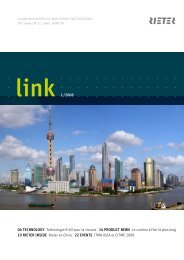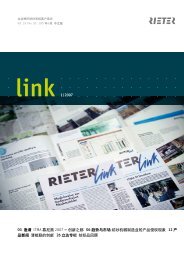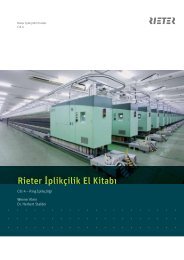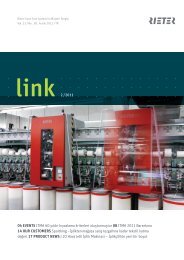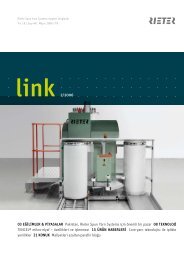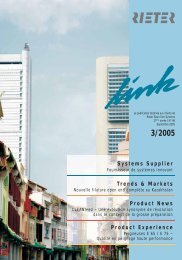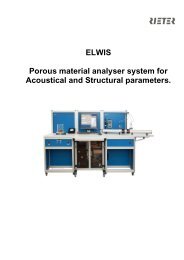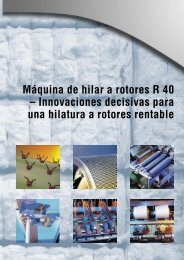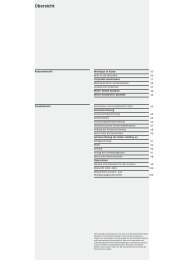link no. 59 customer magazine spun yarn systems - Rieter
link no. 59 customer magazine spun yarn systems - Rieter
link no. 59 customer magazine spun yarn systems - Rieter
Create successful ePaper yourself
Turn your PDF publications into a flip-book with our unique Google optimized e-Paper software.
The higher the grade, the better<br />
6<br />
5<br />
4<br />
3<br />
2<br />
1<br />
0<br />
Fig. 15<br />
PILLING VS. TYPE OF YARN<br />
Knitted fabric, Ne 20, acc. to Martindale, Yarn count Ne 20, Martindale<br />
500 1 000 1 500 2 000 2 500 3 000 3 500 4 000 4 500 5 000 5 500 6 000 6 500 7 000 7 500<br />
Rotor carded, αm = 109<br />
Rotor combed, αm = 109<br />
Cycles<br />
Ring combed, αm = 98<br />
Ring carded, αm = 109<br />
With all the knits examined, the ring <strong>yarn</strong> showed<br />
the worst pilling values. The carded rotor <strong>yarn</strong><br />
achieved the lowest pilling values resp. the best<br />
marks (Figs. 11-14). The greater randomization of<br />
fibers and the wrapper fibers produce resistance to<br />
the formation of fiber pills. It can be clearly seen that<br />
the combed rotor <strong>yarn</strong>s show inferior values to those<br />
of the carded rotor <strong>yarn</strong>s. This fact can also be explained<br />
by the reducing randomization of the fibers<br />
due to the different staple compositions (Fig. 15).<br />
Summary<br />
By means of the combing process, the trash content<br />
is reduced in a range from 60 – 85 %. With a low<br />
combing level, the combing process can certainly<br />
represent a tech<strong>no</strong>logically suitable solution for the<br />
rotor spinning process. The additional short fiber<br />
extraction shows <strong>no</strong> benefit in the question of <strong>yarn</strong><br />
evenness with rotor <strong>yarn</strong>.<br />
That means with the rotor spinning process, short<br />
fibers can be far better guided through the fiber<br />
guide channel than is possible with ring spinning by<br />
means of the drafting arrangement. In contrast, with<br />
the production of ring <strong>yarn</strong> the combing process is<br />
indispensible to improve quality when a higher short<br />
fiber percentage, a lower mean staple or a higher<br />
trash content exist in the cotton.<br />
LINK <strong>59</strong> . 1 /2012<br />
TECHNOLOGY<br />
Such prerequisites have a far less negative effect on<br />
the rotor spinning process than on the ring spinning<br />
process. According to the raw material constellation<br />
and the type of downstream processing, the rotor<br />
spinning process can be considered as more eco<strong>no</strong>mical.<br />
The evenness of the rotor <strong>yarn</strong>s is superior<br />
to that of ring <strong>yarn</strong> in the case of processing carded<br />
Shankar 6 cotton at a <strong>yarn</strong> count of Ne 20.<br />
By means of the combing process, the ring <strong>yarn</strong> quality<br />
can be considerably improved and is only then superior<br />
to the carded rotor <strong>yarn</strong> in the case examined,<br />
with the exception of the hairiness and abrasion resistance<br />
and the pilling values.<br />
The greater hairiness and the associated volume increase<br />
in the ring <strong>yarn</strong> resulted in a better opacity in<br />
the knitted fabric. Normally, a rotor <strong>yarn</strong> is characterized<br />
by a greater <strong>yarn</strong> diameter at equal <strong>yarn</strong> fineness<br />
than with a ring <strong>yarn</strong>. This results in a higher<br />
opacity in the knitted fabric. This effect can be reversed<br />
by a shortening staple length due to the inferior<br />
fiber orientation and bonding in the <strong>yarn</strong> strand.<br />
Ring <strong>yarn</strong> has a softer touch compared to rotor <strong>yarn</strong>.<br />
By means of the combing process with rotor <strong>yarn</strong>, <strong>no</strong><br />
improvement in the knitted fabric can be achieved.<br />
The reduction of the twist coefficient with combed<br />
rotor <strong>yarn</strong> also does <strong>no</strong>t lead to any improvement,<br />
neither in the touch <strong>no</strong>r in the other assessment<br />
criteria. With all the knits examined, the ring <strong>yarn</strong><br />
exhibited the worst pilling values. The rotor <strong>yarn</strong><br />
achieved the best pilling values. 12-111 •<br />
Harald Schwippl<br />
Head Tech<strong>no</strong>logy<br />
Winterthur<br />
harald.schwippl@rieter.com<br />
27



